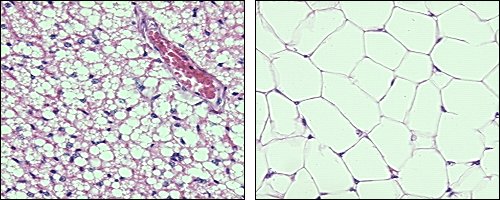VIVO Pathophysiology
Other Topics
Brown Adipose Tissue (Brown Fat)
Everyone is familiar with white adipose or fat tissue, which provides insulation and, by storing triglyceride, serves as an energy depot. Many mammals also have brown adipose tissue, which also stores triglyceride, but has the unique ability to generate heat.
Appearance, Structure and Distribution
Brown adipose tissue is sometimes mistaken for a type of gland, which it resembles more than white adipose tissue. It varies in color from dark red to tan, reflecting lipid content. Its lipid reserves are depleted when the animal is exposed to a cold environment, and the color darkens. In contrast to white fat, brown fat is richly vascularized and has numerous unmyelinated nerves which provide sympathetic stimulation to the adipocytes.
Brown fat is most prominent in newborn animals. In human infants it comprises up to 5% of body weight, then diminishes with age. Substantial quantities of brown adipose tissue can be detected in adult humans using positron-emission tomography, especially when the individuals are exposed to cold temperatures. Most of this tissue in adults is located in the lower neck and supraclavicular region. Intriguingly, there is an inverse correlation between the amount of brown adipose tissue and body mass index, with obese individuals having significantly less of the tissue than lean individuals; this suggests that brown fat may be an important factor in maintaining a lean phenotype.
A good place to observe brown fat is in mice, where it persists into adulthood. Dissection of a mouse will reveal two large, lobulated masses of brown fat on the dorsal aspect of the thorax, between the scapulae. Masses of brown fat are also to be found around the aorta and in the hilus of the kidney.
Examination of sections of white and brown fat at low magnification reveal dramatic differences in structure, as seen below in images of mouse tissues.
- White adipocytes (right panel) have a scant ring of cytoplasm surrounding a single large lipid droplet. Their nuclei are flattened and eccentric within the cell.
- Brown adipocytes (left panel) are polygonal in shape, have a considerable volume of cytoplasm and contain multiple lipid droplets of varying size. Their nuclei are round and almost centrally located.

These features of brown fat are seen at a higher magnification in the image below (H&E stain). Note the adundance of blood-filled capillaries and variable size of lipid droplets.

Electron micrographs of brown fat cells reveal one of their hallmarks: an extraordinary number of mitochondria, which, as described below, are involved in heat generation. The mitochonria are typically round, with cristae across their entire width.
Cell Biology and Function
Brown fat is of particular importance in neonates, small mammals in cold environments, and animals that hibernate, because it has the ability to dissipate stored energy as heat.
In contrast to other cells, including white adipocytes,brown adipocytes express mitochondrial uncoupling protein 1 (UCP1), which gives the cell's mitochondria an ability to uncouple oxidative phosphorylation and utilize substrates to generate heat rather than ATP.
Exposure to cold leads to sympathetic stimulation of brown adipocyte via norepinephrine binding to beta- adrenergic receptors. As in white fat, sympathetic stimulation promotes hydrolysis of triglyceride, with release of fatty acids and glycerol. However, within brown adipocytes, most fatty acids are immediately oxidized in mitochondria and, because of the uncoupling protein, a large amount of heat is produced. This process is part of what is called non-shivering thermogenesis.
The heat produced in brown fat can actually be imaged using a thermal (infrared) camera. If one takes such a picture of an unswaddled infant sleeping at room temperature, "hot spots" can be seen in the skin overlying brown fat deposits in the neck and interscapular area. Brown fat thermogenesis also seems to be of considerable importance to animals coming out of hybernation, allowing them to rewarm.
Finally, it seems that brown fat plays a non-trivial role in control of body weight, and that mitochondrial uncoupling proteins may be one of many factors involved in development of obesity. An interesting demonstration of this is found in a report in which transgenic mice with genetic ablation of brown fat developed obesity in the absense of overeating.
References and Reviews
- Bachman ES, Dhillon H, Zhang C-Y, et al. BetaAR signaling required for diet-induced thermiogenesis and obesity resistance. Science 2002; 297:843.
- Cypess AM, Lehman S, Williams G, et al. Identification and importance of brown adipose tissue in adult humans. New Eng J Med 2009; 360:1509-1517.
- Klass S: Functional differentiation of white and brown adipocytes. Bioessays 1997; 19:215.
- Kuroshima A: Brown adipose tissue thermogenesis as a physiological strategy for adaptation. Japan J Physiol 1993; 43:117.
- van Marken Lichtenbelt WD, Vanhommerig JW, Smulders NM, et al. Cold-activated brown adipose tissue in healthy men. New Eng J Med 2009; 360:1500-1507.
- Virtanen KA, Lidell ME, Orava J, et al. Functional brown adipose tissue in healthy adults. New Eng J Med 2009; 360:1518-1525.
Send comments to Richard.Bowen@colostate.edu